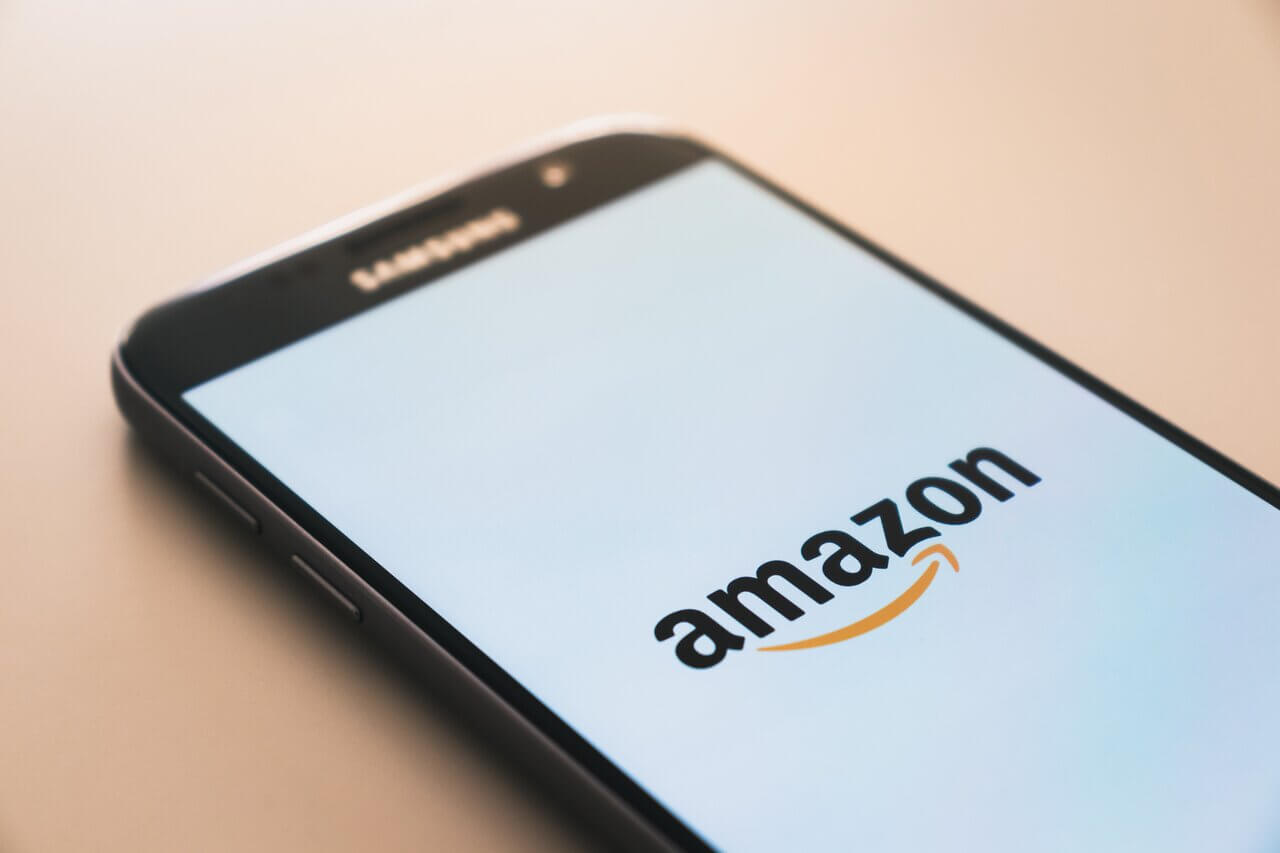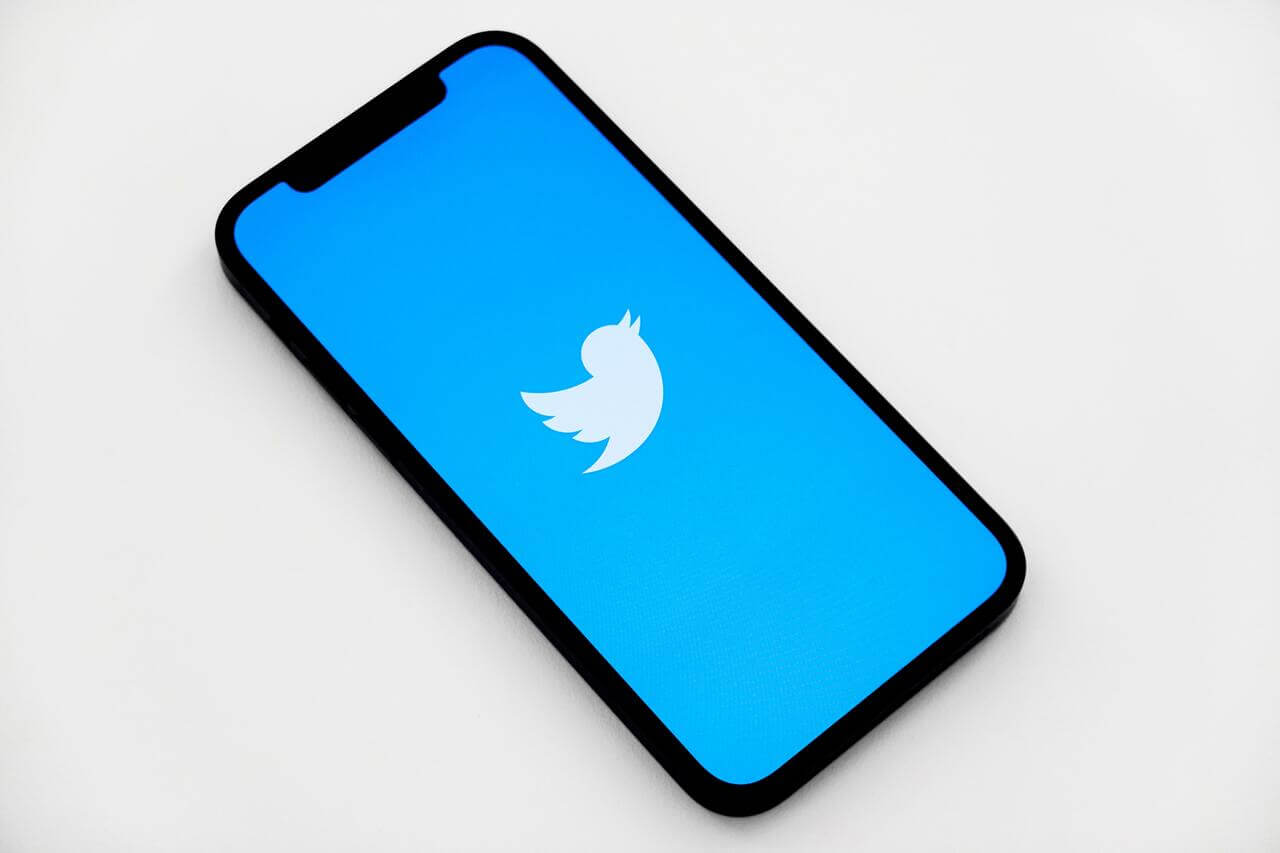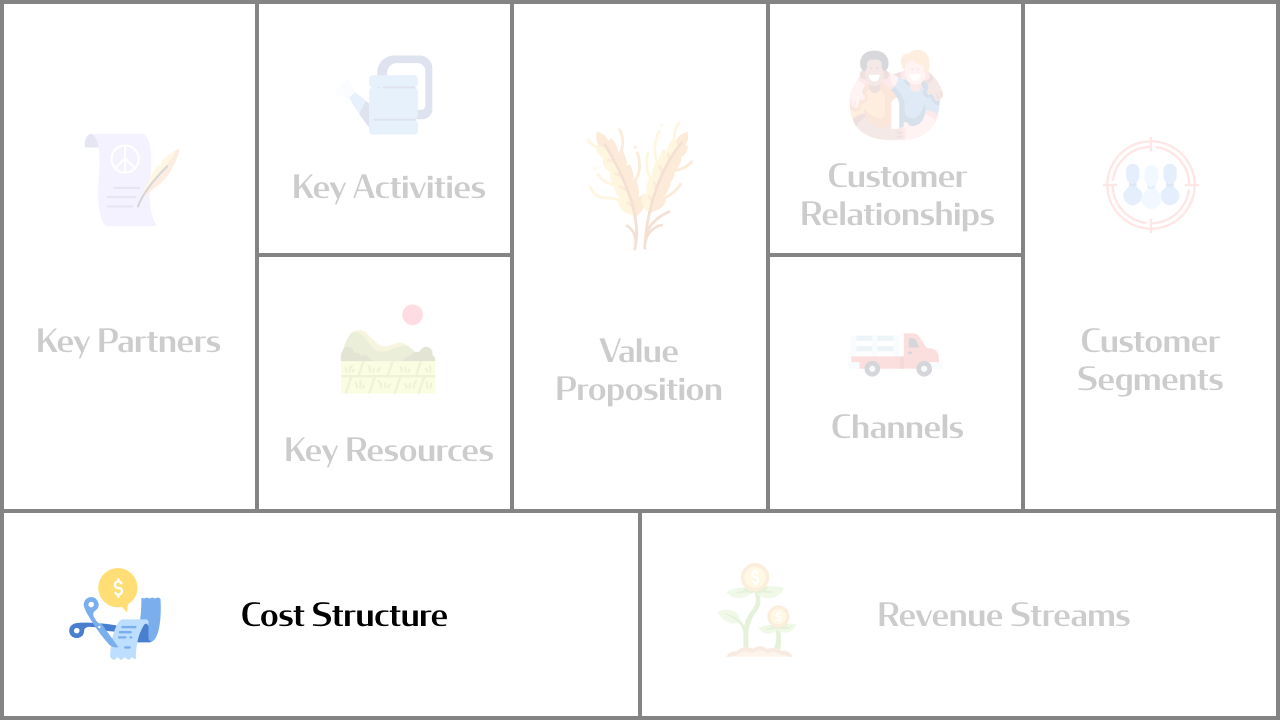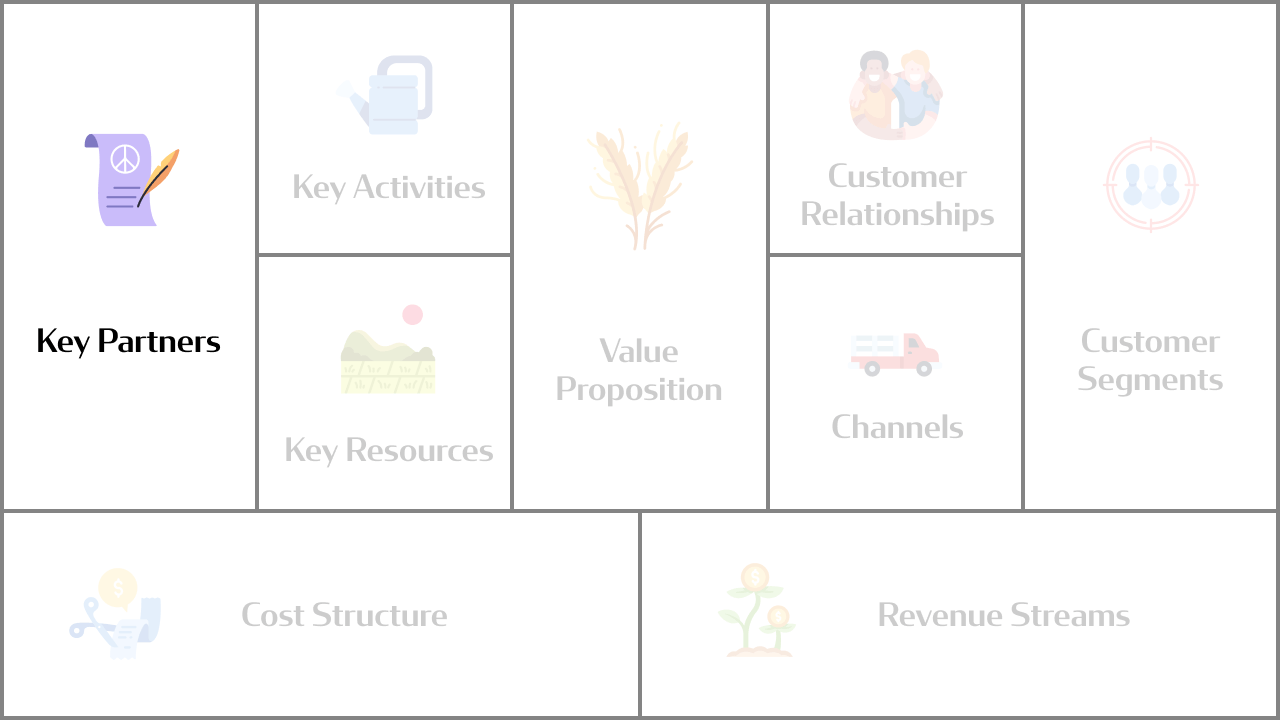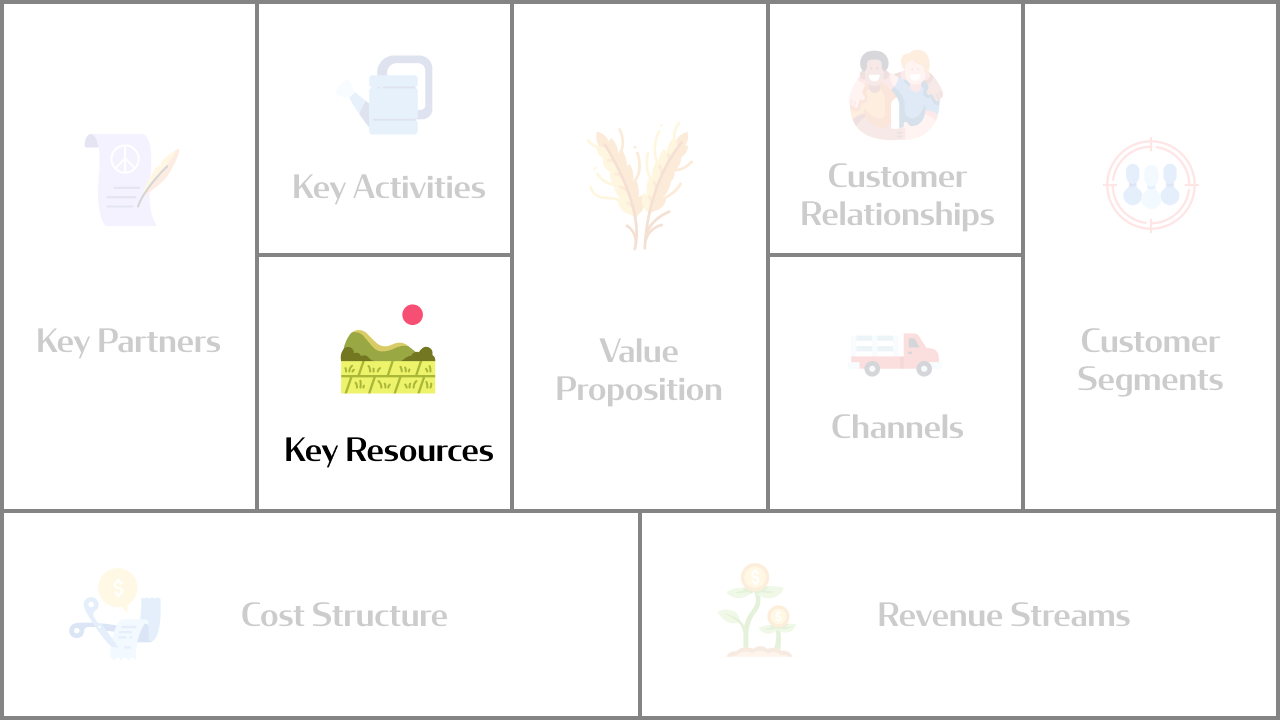In today’s world, there’s nothing that gets our mouth-watering as a successful business with humble garage beginnings. From Amazon and Google to Microsoft, the story of how these mega giants began is told over and over again. Why? Because there’s something inspiring about the common man finding a lucrative business model in their idea.
Computers have been a part of our lives for a couple of decades now. Think about it, what would you do during your workday without a PC? As a leading tech company in the world today, Microsoft has a lasting impact on our work and daily lives. In fact, with a valuation of $2 trillion and a net income of $61.3 billion as of June 2021, it’s hard to think of a company that has had a more profound impact on technology than Microsoft.
However, despite its role in disrupting technology, Microsoft has been saddled with the reputation of being an uninventive company that makes boring products. While there might be some truth in that statement (especially if you compare Microsoft to Google or Apple), Microsoft is still a force to be reckoned with.
So how did Microsoft go from a scrappy startup in New Mexico to a tech giant with more than 47.5% software market share in 2021? The story is not only fascinating, but it’s also full of lessons every new business owner can learn from.

1975-1976: How Microsoft started
It’s April 1975, and then 19-year-old Bill Gates was studying mathematics and computer sciences at Harvard. He had a friend named Paul Allen who worked as a programmer for a company called Honeywell.
Paul Allen and Bill Gates knew each other from a private preparatory school in Seattle, Washington called Lakeside School. They spent hours learning everything they could about the school’s Teletype Model 33 ASR computer as well as a huge and bulky General Electric mainframe.
Allen, who was 22 years old, got the idea to write a code for the Altair computer, which was produced by a company called Micro Instrumentation and Telemetry Systems (MITS). This code would function as an interpreter for the popular BASIC programming language that would run on the Altair computer.
He has seen the January issue of a magazine called Popular Electronics, which featured the Altair microcomputer’s image. This computer was the “World’s First Minicomputer Kit to Rival Commercial Models.”
Allen visited Gates at Harvard to tell him about his coding idea. Excited about the prospects of Allen’s idea, Gates dropped out of Harvard and formed Microsoft out of a garage in Albuquerque, New Mexico. The company name was short for Microcomputer Software, a nod to the new era of microcomputers.
The pair hoped that having a dedicated interpreter for the world’s first minicomputer kit would appeal to hobbyist programmers. These were the people who could now use the code to write and execute their own codes. The interpreter would open up the functions of the Altair 8800, allowing programmers to use the computer for various things such as running thousands of CP/M software titles. It also allowed the average user to play games and create accounting spreadsheets.
Additionally, Allen predicted that the interpreter would make microcomputers cheaper. At some point, developing commercial software for these machines would become a viable and profitable business.
Getting the wheels rolling
The following month in May, Allen and Gates contacted Ed Roberts, the founder of MITS. They offered him an in-person demonstration of their BASIC interpreter for the 8800 computer. Fortunately, Roberts agreed.
The gag, though, was that the interpreter was not ready. Allen and Gates weren’t even sure whether the code worked. So as soon as they secured the meeting with Roberts, Gates started working on the interpreter while Allen worked on the simulator.
Gates flew to MITS’ headquarters in Albuquerque, New, to present the interpreter. On the way to present the product, the boot-up system for the interpreter was not ready, so Gates was writing the last bit of code on the flight.
By the time, he landed he still had not run a full test of the interpreter. Luckily during the meeting, the interpreter ran perfectly the first time. Roberts was thoroughly impressed and agreed to sell their interpreter as Alter Basic.
Little did they know that they had just stumbled on what was to become a major revenue stream for Microsoft; licensing software. Microsoft had managed to carve up a niche for itself in the growing microcomputer industry.
In June, the following month, Allen and Gates sold the license to their code to MITS for $3,000, plus a percentage of royalty payments up to $180,000.
1976: Microsoft is formally registered
Microsoft was formally registered in New Mexico. Allen and Gates used the money to improve their code. Sure enough, Microsoft’s 8800 interpreter became increasingly popular with programming enthusiasts and computer hobbyists. By the end of the year, Microsoft had exceeded $16,000 in revenue.
1979-1980: Building a Monopoly – 1979-1980: Expansion into Asia and Partnership with IBM
By the end of 1978, Microsoft had reached $1 million in annual revenue, thanks to the popularity of the Altair 8800.
Microsoft was facing a skilled staff shortage as the company started growing. They were failing to recruit skilled programmers in New Mexico. So Allen and Gates decided to relocate Microsoft to Washington State and officially opened its headquarters in Bellevue, Washington, on January 1, 1979.
That same year, Gates went into partnership with Kazuhiko Nishi and Keiichiro Tsukamoto to open Microsoft’s first international sales office in Japan, ASCII Microsoft.
Microsoft’s next big break came in the form of a software licensing partnership with IBM in 1980. This propelled Microsoft from a small niche development company to a household name. Before inking the deal with IBM, Microsoft didn’t have its own operating system (OS).
IBM had been toying with the idea of licensing a popular operating system known as the “Control Program for Microcomputers” (CP/M). The program had been developed by Gary Kildall of the California software company Digital Research, Inc.
With the IBM deal, Microsoft was contracted to develop an operating system for IBM’s new PC Model 5150 home computer. So Gates went on the hunt for an OS. He managed to license one developed by Seattle Computer Products known as “Quick and Dirty Operating System.” (QDOS).
Microsoft paid $10,000 for QDOS, which was similar to CP/M in form and function, so it was an ideal system for Microsoft to use. Microsoft started to rewrite a few core parts of the QDOS’s code for Microsoft’s brand-new contract with IBM.
By the end of the year, Microsoft had cemented its position. It was on its way to dominating the software industry.
Microsoft’s Business Model Canvas: The Early Days
At this point, Microsoft’s Business Model Canvas looked like this:
Value Proposition
- Easy to use software code for computer programmers and hobbyists
Customer Segments
- Computer companies like MITS & IBM
Customer Relationships
Channels
- Word of mouth
Revenue streams
- Licensing fees
Key activities
- Developing software
- Developing OS
Key resources
- Microsoft software and OS
- Skilled staff (programmers etc.)
Key partners
- Kazuhiko Nishi and Keiichiro Tsukamoto
- IBM
Cost structures
- Staff
- Acquisitions
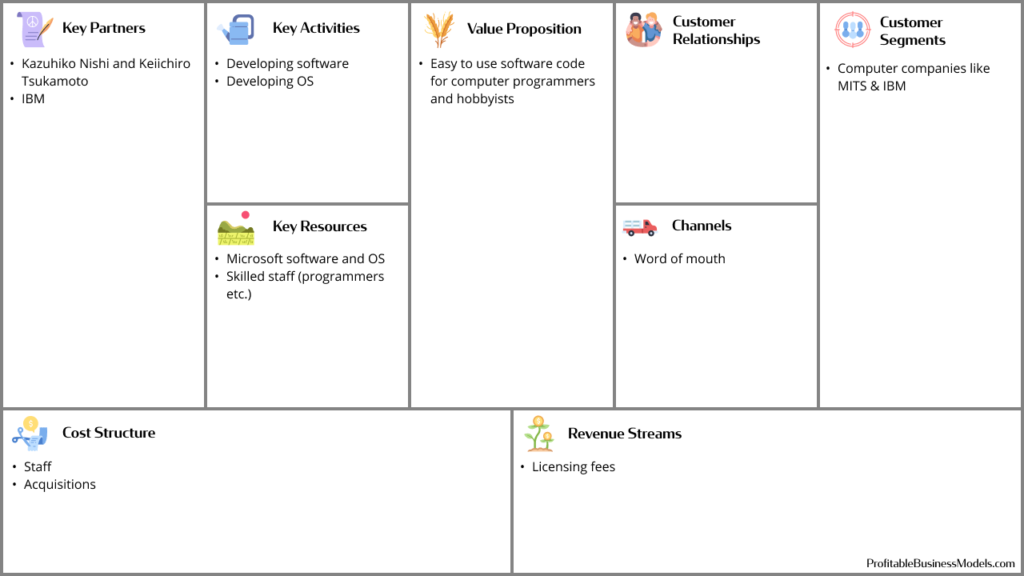
1981-1990: Global Dominance
In July of 1981, Microsoft purchased QDOS from Seattle Computer Products for $50,000. They rebranded the software and called it MS-DOS for its deal with IBM. A crucial condition of the sale was that Microsoft could license the OS to other companies.
Unfortunately, Seattle Computer Products (SCP) later filed a lawsuit against Microsoft. They claimed that Microsoft had intentionally omitted that IBM was one of the first licensees of the MS-DOS. The court sided with SCP ordering Microsoft to pay $1 million in damages.
This approach by Gates is the first example of the tactics that would lend Microsoft in trouble in the 1990s. Gates had created a corporate culture that entailed the company doing anything and everything possible (save for outright illegality) to secure a large chunk of market share.
1983: Taking over the software industry
The IBM deal and the fact that Microsoft still had lasting control over the MS-DOS was a stroke of genius for various reasons and proved to be the company’s golden ticket. Partnering with IBM was a crucial step in securing dominance of the software market because IBM was the computer giant at that time.
Microsoft had put itself right in the middle of the PC wave that was starting to rise. By the end of 1983, Microsoft’s revenues exceeded $55M.
During these early years, Microsoft was slowly developing its sales and manufacturing strategy. As we’ve previously stated, Paul Allen had anticipated an imminent explosion of the PC market.
At this point, Microsoft had very few competitors in the market, so the software didn’t have to be perfect. The sole focus was to get as many users as they could so that revenue would soar.
He had aptly predicted the rise of the consumer software market; thus, the company focused on quantity, not quality. So the company launched two of its iconic products that same year. The first was the Multi-Tool Word. The second was the Xenix operating system, a clone of AT&T’s Unix system that Microsoft had licensed in the late 1970s.
The Multi-Tool Word was one of the first software programs that relied primarily on mouse-based input to navigate the tool’s graphical user interface (GUI). While the tool was mainly aimed at computing enthusiasts, even the average PC user was amazed by the program’s visual interface.
1985: The launch of Windows
In 1985, Microsoft released its first retail version of Windows in 1985. Gates and Allen realized that their target market (computing enthusiasts) was slowly becoming interested in moving away from command-line interfaces in favor of GUIs.
This flagship OS was actually a GUI for MS-DOS. This first Windows was a significant step forward for Microsoft in home computing. However, the launch was not without controversy because Apple launched a lawsuit accusing Microsoft of infringing its own GUIs.
In an ironic twist, Apple lost the suit against Microsoft before fighting its own court battle against Xerox, which was accusing Apple of infringing on its GUI copyrights in Apple’s Lisa and Macintosh operating systems.
With the lawsuit settled, Microsoft released the first version of Excel in 1985, specifically for Apple’s Macintosh. Microsoft’s Windows version of Excel wouldn’t actually be released until 1987.
The launch of Excel was a massive milestone for the company. They were now slowly building towards Microsoft’s bundled Office package. The package would ultimately help the company secure an even greater market share in the rapidly growing productivity software market.
The year 1985 wasn’t just all about essential product launches; Microsoft managed to enter into another critical partnership with IBM. The new deal cemented MS-DOS as the default operating system of IBM’s new line of home PCs.
So now, not only would Microsoft continue to dominate the home computing market with MS-DOS, but they could also sell and license its OS to other companies. The deal also had some significant benefits for IBM. It eased the fears and rumors that IBM was developing and migrating to its own closed-source proprietary operating system
1986-1989: The Office Package makes a debut & Microsoft goes Public
Microsoft continued to dominate the late 1980s. In 1986 the company went public, and the opening stock price was $21. In 1989, they released the first version of the Office suite of productivity applications. There was no question of Microsoft’s position in the software company in North America.
However, as good as the Office suite was, Microsoft missed a critical aspect of the home computing market—the internet. As the ’90s rolled around, the internet was becoming more mainstream. Computer users were beginning to buy hardware and software; however, Microsoft continued to prioritize the development of boxed software. This was a grave misstep that would almost bring the company to its knees.
Microsoft’s Business Model Canvas: The Expansion Days
At this point, Microsoft’s Business Model Canvas looked like this:
Value Proposition
- Compatible software for home and office use
Customer Segments
- Business users
- Personal users
Customer Relationships
- Business sales and support
Channels
Revenue streams
- Licensing fees
Key activities
- Developing software tools like Multi-Tool Word and the Xenix
- Software acquisitions
- Sales
Key resources
- Software
- Employees
Key partners
- IBM
- Apple
Cost structures
- Acquisitions
- R&D
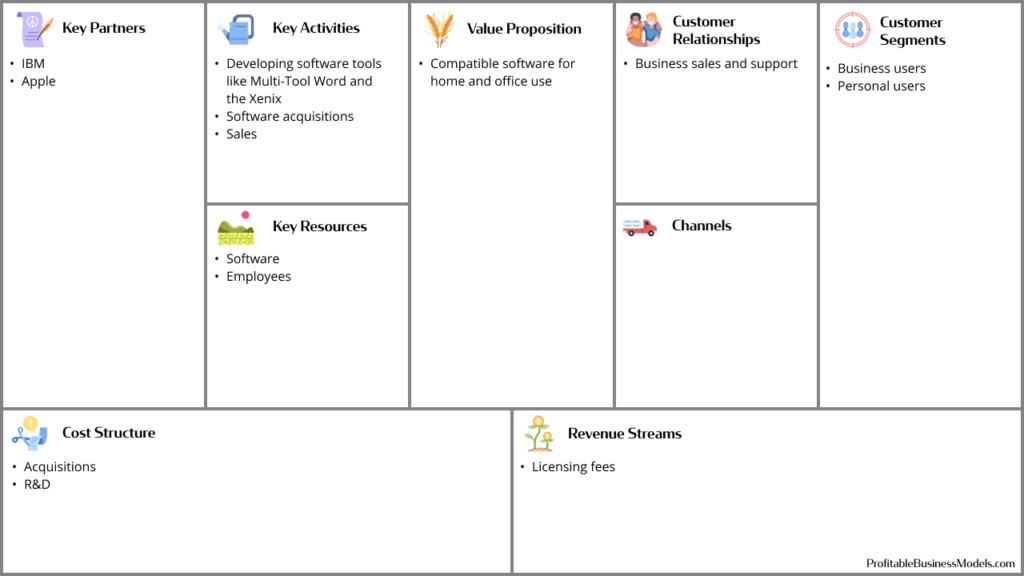
1990-2000: Market Dominance
1995: Windows 95 is launched
Throughout the early ’90s, Microsoft continued to develop its flagship Windows product and started with the release of Windows 3.0 in 1990. And in 1995, the company launched Windows 95, which was to be Microsoft’s most important product launch to date.
Windows 95 was the first time that MS-DOS and Windows environments could be run on the same machine using the same GUI. This move gave many users’ preference for GUI-based operating systems and was designed to preempt Apple’s growing market share.
Apple was mainly a consumer-focused company, while Microsoft was targeting business environments. Hence, Apple posed no real threat at this point to Microsoft’s dominance. However, Microsoft realized they couldn’t allow Apple to make any further gains into the growing consumer market.
So that same year, Microsoft also began to take the internet seriously and unveiled their own browser, the Internet Explorer. This was a response to the launch of the Netscape Navigator Internet browser.
However, Microsoft didn’t want to let the market decide who would emerge victorious in the browser wars. Therefore in 1996, upon the release of Internet Explorer 3.0 in 1996, Microsoft once again bundled Internet Explorer with Windows. This solidified the company’s stranglehold on the emerging browser market.
This strategy worked, and by 1997, Microsoft had revenues exceeding $11 billion, and the return on revenue was more than 30%. Apple, on the other hand, was not performing well at all. Sales were going down, and badly the company stood on the brink of bankruptcy. (To read more about Apple’s woes at this time, read Apple’s business model canvas and its history.)
1997: Microsoft invests in Apple
In a move that rocked the tech world, Apple’s Steve Jobs announced that Microsoft would invest $150 million in Apple. Microsoft would be developing a series of applications for the Mac OS, including a native version of the Office suite package.
There’s no doubt that this move by Microsoft “saved” Apple during Apple’s darkest hour. Although some would argue that there was no genuine benevolence on Microsoft’s side. They believe Microsoft needed to score some good PR points, and bailing out an “enemy” was an excellent way to accomplish that. The ultimate goal for Microsoft was to control and eventually crush the competitor.
This relentless pursuit of dominating the PC market and the readiness to control and crush competitors would soon lead Microsoft to the brink of death.
2000-2010: Rebuilding Trust and the Ballmer Era
2000: Bill Gates steps down as Microsoft’s CEO
Although Microsoft’s annual revenues exceeded $22 billion by the early 2000s, the company had been severely bruised by its numerous legal battles. They would spend the next few years attempting to restore its public image.
Bill Gates announced that he was stepping down as CEO of the company and was now working as a Chief Software Architect. Steve Ballmer was named as his replacement. This marked the beginning of significant challenges for Microsoft as the once-mighty company struggled with botched product launches and a severe identity crisis.
Up to this point, Microsoft had been extraordinarily successful at building strong software products. Unfortunately for Microsoft, their confidence in the security of dominance would jeopardize everything Microsoft had made thus far.
When Ballmer took over, Microsoft was valued at $558 Billion. The company was doing reasonably well with its internet products, and sales of Windows remained comparatively strong. However, their sole reliance on boxed software was slowly becoming a liability.
It was becoming increasingly popular to distribute software over the internet. Despite Microsoft’s uncontested dominance, it was clear that there was a growing need to find new revenue streams.
2001: Microsoft Expands Product Catalogue; Hello Xbox!
So in 2001, Microsoft decided to venture into the video games business with the release of the first-generation Xbox gaming console. The following year in 2002, Microsoft launched its online gaming network, called Xbox Live.
This was a brilliant move, and surprisingly the Xbox hardware was a resounding success.
Even more remarkable was that Microsoft was able to enter a crowded and highly competitive retail market with a brand-new product and nail it. After several failures, the success of the Xbox was a major relief.
Unfortunately, this success was short-lived. There’s no doubt that Microsoft was still the go-to for companies and corporations. Their early dominance had made sure that companies had built their workflows around Microsoft’s business productivity tools.
However, at this point, Microsoft was struggling to develop consumer products that people actually wanted. This became a big problem as competitors began to emerge that offered fundamentally better products than Microsoft’s.
2006-2009: Huge Product Failures
The period from 2006 to 2008 was particularly troublesome for the failing giant. Microsoft experienced a series of high-profile product failures that did extensive damage to Microsoft’s already bruised reputation.
For example, the immensely unpopular Zune MP3 player was launched as a direct response to Apple’s iPod. While there was nothing wrong with the Zune per se, it didn’t offer users anything different from Apple’s iPod. Moreover, Apple already had a five-year head start.
The Zune was followed by the release of Windows Vista, which most experts deemed an utter failure because it was not an improvement of its predecessor, Windows XP. So the company had inadvertently set itself up for failure by backtracking on everything that made the XP OS so popular.
The cracks in Microsoft’s early culture of dominating by sheer force of numbers, as opposed to creating genuinely superior products, were now showing.
Some relief came in the form of Windows 7, which Microsoft released in 2009. Although it was a considerable improvement from Vista. Windows 7 directly addressed several of the unpopular Vista features such as; hardware compatibility issues and user account control issues. It was not a home run swing for Microsoft.
The tech giant completely mishandled the product launch. One major issue what that Microsoft released six different versions of Windows 7.
The sheer number of packages confused consumers. They received little guidance on what features came with each version or which version was right for them. This further demonstrated how Microsoft was struggling to understand its target market for this product. How could that be, you ask?
Well, Microsoft knew its early buyers, the manager of companies, not the user. The Windows 7 packages were meant for the user. So effectively, Microsoft packaged a consumer product for the business market.
The launch of Bing & Windows Phone
Once again, Microsoft was late to the party when it launched the Bing search engine in 2009. The goal for Microsoft was to start chipping away at Google’s market share and the massive advertising revenues.
Bing was a poor imitation of the mighty Google, who had a five-year lead, controlled more than 64% of the U.S. search market, and earned approximately $22B in ad revenues from Google AdWords.
Finally, one of the biggest failures for Microsoft came in the form of the Windows Phone. Surprisingly the devices that ran Microsoft’s mobile OS weren’t the problem. In fact, many Windows Phone devices ran a lot smoother compared to Android devices.
The problem was Google. By the time the Windows Phone launched, Google had developed the very popular Android platform that dominated the mobile market. Google refused to develop apps for the Windows Phone, meaning apps such as YouTube were not available on Windows Phone devices. In general, the Windows Phone was very unpopular with consumers.
Despite these challenges, Microsoft ended the decade on a high note. It had secured at least 92% of the world’s operating system market, but it was struggling to get a foothold.
Microsoft’s Business Model Canvas: The Dominant Days
At this point, Microsoft’s Business Model Canvas looked like this:
Value Proposition
- Personal Computing (Microsoft OS)
- Productivity (Microsoft Office)
Customer Segments
- Business PC users
- Personal PC users
- Gamers
- Mobile Phone users
Customer Relationships
- Sales and support
Channels
- Media
- Website
- PCs preinstalled with Windows
Revenue streams
- Software licensing fees
- Advertising on Bing
Key activities
- Product Expansion
- Acquisitions
- R&D
- Releasing new, unstable versions of windows
Key resources
- Software
- Employees
- Technological Infrastructure
- Brand
Key partners
- Apple
- Developers
- Retailers
Cost structures
- Acquisitions
- R&D
- Distribution
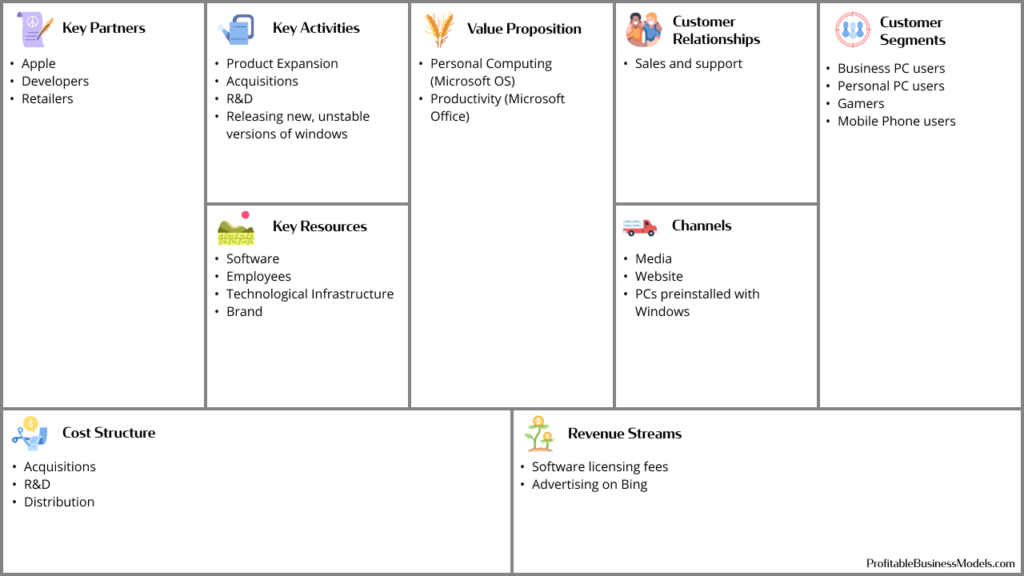
2011-Present: Rising from the Ashes
By 2011, Microsoft was spiraling out of control. The company was struggling to adapt its business to the changing nature of software distribution. Additionally, the numerous product failures confused consumers and cast doubt on Steve Ballmer’s leadership.
Microsoft was facing bitter competition from several Silicon Valley tech companies such as Apple and Google to make matters worse. Google, in particular, had gained significant traction by creating a suite of office tools available to users for free. This was a direct jab at Microsoft’s core business, selling boxed software.
Microsoft debuts Office 365
In an attempt to invigorate its ailing product division, Microsoft debuted Office 365 in 2011. This moved more of Microsoft’s services to the cloud. Soon after launching Office 365, Microsoft announced it was acquiring VoIP telecom service Skype for $8.5B. This was the company’s largest acquisition at that time.
The acquisition raised eyebrows, mainly because most people didn’t see why and how Microsoft could fit Skype within its business model. The company already had Live Messenger and Lync 2010, which had three times as many users as Skype. Additionally, on its own, Skype was struggling to reach profitability.
It made no business sense, especially because Microsoft was paying more than $1,000 to acquire each of Skype’s paying subscribers. This figure was way more than each individual customer represented in terms of profit.
So why did Microsoft make such an ill-advised purchase? The simple truth is that Microsoft bought Skype so that Google or Facebook wouldn’t. There had been a lot of speculation and rumors stating that Google, Facebook, and Skype were entering into an agreement. Microsoft could not afford to let such a partnership happen.
2012: Microsoft Surface & Windows 8
Once assured that it was slightly out of danger, Microsoft focused on their next big project, which was Surface. While the company may have shifted its focus to cloud-based services and online software, it hadn’t given up on securing another major hardware product win.
The Surface range of devices was unveiled at an event at Los Angeles’ Milk Studios. This was a unique product radically different from Microsoft’s historical modus operandi. And surprisingly, the company had designed the Surface in-house specifically for Windows software. Thankfully, the Surface was immediately and wildly popular.
It came in two versions; a consumer-focused model optimized for Windows RT and a heavier model aimed at business users. Riding high on the success of the Surface launch, Microsoft could have leveraged the resurgence in its popularity to reinvent itself and finally shake its reputation as an out-of-touch company with few ideas.
Unfortunately, it released Windows 8 instead, which really showed that Microsoft hadn’t yet learned its lesson. Again while Windows 8 had significant improvements, the presentation and user interface confused many users and put off a lot more.
In one awful review, one tech journalist described Windows 8 as “a Frankenstein’s monster of cobbled together parts that are clumsy and impractical.”
Ballmer’s reign at Microsoft ended in 2014 when Satya Nadella took over, arguably saving Microsoft from a disastrous path.
2014: Nadella Restructures Microsoft
Microsoft wasn’t just suffering financially; morale among the staff had also hit rock bottom because of the constant product launch failures. Everyone was burnt out.
His first primary focus was to shift the perspective that everyone in the tech world had about Microsoft. So Nadella announced that Microsoft was developing an iOS-native version of Office for Apple’s iPad.
Microsoft was now abandoning its isolationist stance, as it was clear to Nadella that some cooperation and collaboration would benefit the company. He was focused on bringing Microsoft into the digital era.
2015: Windows 10 fails to make an impact
In July 2015, Microsoft launched Windows 10, and true to form, the product failed to hit the mark. While it looked great on the surface and featured Microsoft’s savvy Cortana virtual assistant as well as the company’s Edge browser, the same problems still plagued the product.
For one thing, Microsoft was forcing users to upgrade even if they were happy with their existing Windows OS. Additionally, many customers were not too pleased with Windows 10’s built-in advertising. The ads were everywhere, on the recommended “suggested” apps from Windows 10’s home screen and the Start Menu.
The OS also frequently prompted users to upgrade to paid subscriptions of Office and other software tools. Simply put, Windows 10 was now an advertising platform that worked as an OS.
Again Microsoft was failing to carve an identity for itself in this new era. And between 2015 and 2018, the company flew under the tech industry’s collective radar. There were no major product launches during this time. Although the company was heavily investing in AI and Machine Learning, they had joined the game too late.
Nevertheless, Nadella’s influence on Microsoft’s corporate culture and business model could be seen. The company began building partnerships with Apple, IBM, and Google, to name a few. Integrating Microsoft’s products with many of its former enemies. Time will tell whether this will be enough.
Conclusion
Microsoft started off well and lost the plot along the way. Remarkably few companies would have survived the missteps and, at times, laziness that plagued Microsoft. In a world where competitors are emerging, innovating, and developing faster than you, complacency is unforgivable. This is a lesson that every business owner should remember.
However, for all its faults, Microsoft’s modern computing market would not be where it is today. Hopefully, under Nadella, we will see the company becoming more competitive, relevant, and profitable in the future.
Sources
- https://nira.com/microsoft-history/
- https://www.investopedia.com/how-microsoft-makes-money-4798809
- https://news.microsoft.com/facts-about-microsoft/
- https://www.investopedia.com/articles/markets/111015/apple-vs-microsoft-vs-google-how-their-business-models-compare.asp
- https://www.thestreet.com/technology/history-of-microsoft-15073246
- https://www.reuters.com/article/us-microsoft-succession-timeline-idUSBREA131R720140204
- https://hostingtribunal.com/blog/microsoft-statistics/



